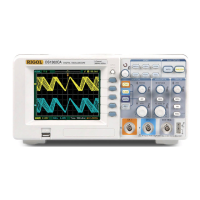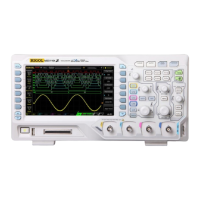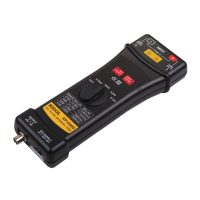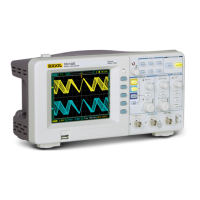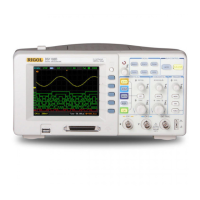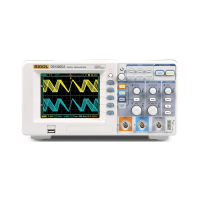Chapter 3 Performance Test RIGOL
Service Guide for DS1000E, DS1000D Series
Bandwidth Test
Specification:
Explanation:
Amplitude loss (dB) = 20×lg
(Vrms2/Vrms1)
Test device: Fluke 9500B
Test Procedures:
1) Connect the active head of Fluke 9500B to CH1 of the oscilloscope.
2) Enable the Fluke 9500B and set the output impedance to 1 MΩ.
3) Output a sine signal with 1 MHz frequency and 600 mVpp amplitude from
Fluke 9500B.
4) Configure the oscilloscope:
a) Press CH1 in the vertical control area (VERTICAL) at the front panel to
enable CH1.
b) Rotate HORIZONTAL SCALE to set the horizontal time base to 500
ns.
c) Rotate VERTICAL SCALE to set the vertical scale to 100 mV/div.
d) Rotate HORIZONTAL POSITION and VERTICAL POSITION
to set the horizontal position and vertical position to 0 respectively.
e) Rotate TRIGGER LEVEL to set the trigger level to 0 V.
5) Enable the root mean square measurement function of the oscilloscope.
Read and record Vrms1.
6) Output a sine signal with 100 MHz frequency (for 50 MHz bandwidth
oscilloscopes, the frequency is 50 MHz) and 600 mVpp amplitude from Fluke
9500B.
7) Rotate HORIZONTAL
SCALE of the oscilloscope to set the horizontal
time base to 5 ns (for 50 MHz bandwidth oscilloscopes, the time base is 10
ns).
8) Read and record the root mean square Vrms2.
9) Calculate the amplitude loss: amplitude loss
(dB) = 20×lg
(Vrms2/Vrms1)
.
10) Keep the other settings of the oscilloscope unchanged and set the vertical
scale to 200 mV/div and 500 mV/div respectively.
11) Output sine signals with 1 MHz frequency and 1.2 Vpp/3 Vpp amplitude from
Fluke 9500B respectively.
12) Repeat step 5).
13) Output sine signals with 100 MHz frequency (for 50 MHz bandwidth
oscilloscopes, the frequency is 50 MHz) and 1.2 Vpp/3 Vpp amplitude from
Fluke 9500B respectively.
14) Repeat steps 7), 8) and 9).
15) Turn CH1 off. Test CH2 according to the above test steps and record the test
results.

